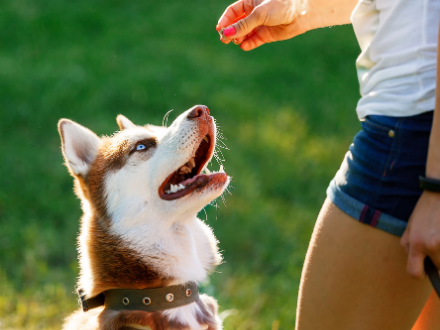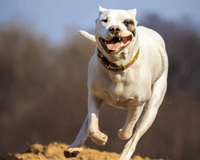Are you thinking of getting a dog training collar? There are many reasons why dog parents use a dog training collar. Many feel like they have exhausted all their options and feel like this is their last resort.
If your dog is constantly barking, bolting out the door, playing rough, or you're having a tough time training your dog, a training collar could help you.
If you are considering getting a training collar, read on for five tips to make the most of your dog training collar!
What is an E-Collar for Dog Training? What is a Dog Training Collar?
But before we get into the tips, let's understand what a training collar is.
A dog training collar is also commonly called an e-collar. It's a system with a remote control and receiver your dog wears.
Dog training collars commonly have different distraction modes to distract your dog from behaviours. Usually, the different modes are Sound, Vibration and Static.
The remote control allows for manual training. So it works very well for non-repetitive behaviours like teaching your dog recall or teaching them not to jump.
Note: When used properly, the dog training collar is completely safe.
What Age Should You Start Training with a Dog Training Collar?
Training collars are safe for dogs over six months old. When dogs are younger than this, they may not have the basic commands locked in, making dog training collar confusing.
Before you start with a dog training collar, your pup should also be consistent with their basic commands of "sit", "come", and "heel".

Dog Training Collar Tip 1: Find the Collar Setting for your dog
Finding the right setting for your training collar is essential! Ideally, the setting is just enough for your dog to notice the distraction and stop what they're doing. You'll want to start low and see how your dog reacts to the distraction. Some dogs might not feel or hear the lowest settings, but you should always start low to test this. The distraction should never harm your dog or put them through necessary stress.
Most dog training collars will have different modes (Sound, Vibration and Static) and levels to customise the distraction for your dog (depending on the nature, size and breed).
To find the right setting for your dog, start with the lowest mode and intensity (i.e. Sound at level 1), observe your dog and see if they react to the distraction. Look for behaviours like stopping and looking around, turning their head over their shoulder, or shaking their head.
If they don't react to the distraction, gradually increase the level or mode of distraction. The ideal setting is one that is high enough for your dog to notice but doesn't cause your dog stress. Once you have found the setting, test out the distraction randomly to make sure they are reacting to the dog training collar.
Dog Training Collar Tip 2: Make Sure the Collar Fits Properly
Fitting a dog training collar requires more technique than you may think! The collar should always fit and be positioned correctly.
When placing the collar on your dog, make sure it is turned off. Fit the collar on your standing dog. You should be able to fit one to two fingers between the collar and the dog.
Use your discretion when fitting the collar with your fingers as the measurement gauge. On a small dog like a Chihuahua, you'd only make a one-finger difference as a two or three-finger spacing means the collar is likely to fall off the dog.
A two-finger difference in a large fluffy dog like a German Shepherd will make the collar comfortable without running the risk of it falling off.
The receiver should sit high on the side of the dog's neck (not the throat). If you use the collar multiple days in a row, swap the side where the receiver sits to avoid irritation.

Let your dog get used to the collar, and put the collar on your dog for a few hours every day before even turning it on. It teaches your dog that the dog training collar is like any other collar. We don't want your dog only to behave well when wearing a training collar.
Dog Training Collar Tip 3: Use Consistent Commands
Before adding a training collar into the mix, ensure your dog knows the basics, "Sit", "Come", and "Heel" it's vital that they are consistent with these commands.
When introducing new commands with the training collar, keep these commands consistent. Use the same word for the same behaviour every time.
And don't forget rewards to make your dog's training sessions light and fun!
Once you have introduced a new command, use the same sequence for every command.
In the example of teaching recall, the sequence would be:
- Verbal command "here."
- Begin to send a distraction
- Use a lead to gently pull your dog in towards you
- Reward
You'll know they are improving when they respond immediately to your "here" command.
Dog Training Collar Tip 4: Know The Limits
Dog training collars are a fantastic tool for those who wish to train specific behaviours out of their dog (recall, jumping, rough play)
But they do have limitations. For example, you might need a slightly different product if you expect the collar to help stop your dog from escaping your property.
Or, if your dog has an excessive barking issue, look for a dog training collar that comes with an auto-bark feature, or consider a bark collar. An auto-bark collar will detect excessive barking and automatically deliver a distraction. This is much easier than trying to wait and use the remote each time your dog barks excessively.
If your dog is a bit of an escape artist, a dog e-fence might be a better solution. An e-fence collar will only emit a distraction to your dog if they are too close to a fence boundary. You get to tailor where that boundary is. Maybe it's around your garden bed, along a specific fence line or around an animal enclosure.
If you find yourself using the remote training collar for your dog barking or escaping, consider if these options are a better fit.
Dog Training Collar Tip 5: Do Your Research
Dog training is challenging but very rewarding. When you add another tool, like a dog training collar, you need to research how to implement it in your training.
Knowing the capabilities of a dog collar, its limitations, and how to use it is hugely beneficial.
We recommend collating information from multiple dog trainers to learn their approaches and pick up on the common themes and small tips & techniques to build your training routine. No dog will ever be the same, so training every dog will be different.
If you have any questions about which collar best suits your dog, don't hesitate to contact our customer service team. We love to match dogs and their owners with an collar that suits their training and lifestyle needs.









